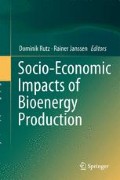Abstract
Soybean production is immersed within a productive system that cannot be analyzed on its own. A number of political and market factors, both nationally and internationally, explain the development and growth of soybean production throughout the globe. In the case of Argentina, the evolution of the agricultural system of soybean production has been characterized by continuous technological improvement. This has changed the whole agricultural system and set the base for society growing demands for environmental and socially responsible goods. An advancement of the regulatory frameworks has allowed a better control of the future development of land use. In Argentina’s case the law of minimum budget is an example towards that direction. Over the last decades, soybean cultivation has faced unprecedented growth. Since the 70’s soy cultivation areas have grown, representing 37,000 ha in the 1970/1971 campaign to more than 17 million ha today. The Argentinean soy industry is one of the most dynamic economic sectors of the country, generating almost 30 % of the external currencies’ income due to exports and representing almost 30 % of GDP from the agro-industrial sector. Argentina is the world’s leading exporter in soybean oil, soy meal and soy biodiesel and the third one in soybeans.
Access this chapter
Tax calculation will be finalised at checkout
Purchases are for personal use only
Notes
- 1.
This group privileges the installation of a biodiesel plant near its oil factory (at Frías, Province of Santiago del Estero), becoming the only mega-plant located far from Rosario.
- 2.
On average, Argentina biodiesel factories have a capacity of 135 million liters per year. On the other hand, the Brazilian and European factories can process an average of 80 to 100 million liters per plant per year.
References
AAREA. (2005). Agroalimentos Argentinos II, Área de Economía de AACREA. http://www.fediap.com.ar/administracion/pdfs/Agroalimentos. Argentinos II—ACREA.pdf. Accessed 15 July 2012.
Aizen, M. A., Garibaldi, L. A., & Dondo, M. (2010). Expansión de la soja y diversidad de la agricultura argentina. Ecología Austral, 19(1):45–54.
Administracion Federal de Ingresos Publicos (AFIP). (2013). Database. http://www.afip.gov.ar.
Camara Argentina de Biocombustibles. (2012). Carta al Ministro de Planificación Federal, Inversión Pública y Servicios. Arq. Julio de Vido, sobre Situación de la Industria del Biodiesel en Argentina.
Hilbert, J. A. (2012). Producción de biodiesel a partir de aceite de soja. Contexto y evolución reciente. Buenos Aires. http://inta.gob.ar/documentos/produccion-de-biodiesel-a-partir-de-aceitede-soja.-contexto-y-evolucion-reciente-1. Accessed 15 December 2012.
Hilbert, J. A., & Galbusera, S. (2012b). Actualización del cálculo de la reducción de emisiones producidas por el corte obligatorio. http://inta.gob.ar/documentos/actualizacion-del-calculode-la-reduccion-de-emisiones-producidas-por-el-corte-obligatorio.
Keyzer, M. A., Merbis, M. D., Pavel, I. F. P. W., & van Wesenbeeck, C. F. A. (2005). Diet shifts towards meat and the effect on cereal use: can we feed the animals in 2030? Ecological Economics, 55(2):187–202.
Thompson, W. N. (1981). Increasing the supply of soybeans. J Am Oil Chem Soc, 58(3), 140–142.
Tomei, J., & Upham, P. (2011). Argentine clustering of soy biodiesel production: the role of international networks and the global soy oil and meal markets. Open Geography Journal, 4, 45–54.
van Dam, J., Faaij, A. P. C., Hilbert, J. A., Petruzzi, H., & Turkenburg, W. C. (2009). Large-scale bioenergy production from soybeans in Argentina, Part B. Environmental and socio-economic impacts on a regional level. Renewable Sustainable Energy Reviews, 13(8), 1679–1709.
Vilella, F., Senesi, S. I., Dulce, E., Pérez San Martín, R., & Daziano, M. (2010). El Sistema de Agronegocios en la Argentina, su cadena y perspectivas para 2020. Buenos Aires: ACSOJA-Bayer.
Author information
Authors and Affiliations
Corresponding author
Editor information
Editors and Affiliations
Rights and permissions
Copyright information
© 2014 Springer International Publishing Switzerland
About this chapter
Cite this chapter
Hilbert, J., Galligani, S. (2014). The Use of Soybean By-Products as a Biofuel: The Argentine Case. In: Rutz, D., Janssen, R. (eds) Socio-Economic Impacts of Bioenergy Production. Springer, Cham. https://doi.org/10.1007/978-3-319-03829-2_8
Download citation
DOI: https://doi.org/10.1007/978-3-319-03829-2_8
Published:
Publisher Name: Springer, Cham
Print ISBN: 978-3-319-03828-5
Online ISBN: 978-3-319-03829-2
eBook Packages: Earth and Environmental ScienceEarth and Environmental Science (R0)

